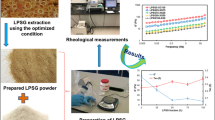Abstract
Many industrial products often include in their formulation more than one polysaccharide to achieve the desired properties during and after processing. Many such mixed systems behave as would be expected from the known properties of the individual polymers. In others, however, their properties are superior to those of either component alone, or may be qualitatively different. In many polysaccharide systems, the combination of a gelling polymer with a nongelling one gives rise to strong synergistic effects, as a consequence of interaction among different chain polymers and formation of mixed junction zones.
Probably, the most exploited mixed gels, especially by the food industry, are those involving the microbial polysaccharide xanthan gum (XG) and the plant galactomannans, like locust bean gum (LBG). Concentrated aqueous systems of LBG and XG display quite different rheological properties: the former show the behaviour typical of hyperentangled macromolecular solutions, whereas the flow and viscoelastic properties of XG systems correspond to those of tenuous, weak-gel networks. Interestingly, when mixed together these macromolecules interact to form a firm, thermoreversible gel with synergistic effects.
In the present paper we report the results of a thorough investigation of both polymer concentration and temperature effects on the rheological properties of mixed LBG-XG systems in 20 mM KCl under continuous and oscillatory flow conditions.
Under continuous shear at 25°C, pure LBG shows the flow properties of a macromolecular solution, with a shear-thinning behaviour and a Newtonian region at low shear rates, whereas the rheological behaviour of XG and all LX mixed systems is that typical of weak-gels. Furthermore, in the mixed systems the viscosity values do not increase monotonically with increasing xanthan concentration, but the synergistic effect has a maximum in accordance with the XG:LBG ratio 1:1. As the temperature is increased from 25°C to 85°C, whilst the LBG system do not show any qualitative change but there is only a parallel, downward shift of viscosity values, in the case of xanthan there is a dramatic change in the corresponding curve profiles, due to the thermally induced helix-coil conformational transition.
The differences in the rheological behaviour of the systems examined can be better shown through dynamic tests at 25°C. The strain sweeps performed at constant frequency of oscillation reveal that the mixed systems show higher sensitivity to strain amplitude, and lower strain values must be attained to ensure linear viscoelastic properties. The mechanical spectra clearly show the influence of composition on the viscoelastic properties of these biopolymer systems. All LX systems show the mechanical spectra typical of polysaccharide gels: G′ is always much greater than G″ and is nearly independent of the applied frequency over a wide frequency range. In addition, the marked gap between the elastic responses of the pure LBG and the LX 1:3 systems demonstrates the strong effect of the initial addition of xanthan to the pure LBG, especially in the low frequency range, whereas the highest synergistic effect is attained for the LX 1:1 system. A comprehensive description of the frequency dependence of both moduli can be suitably obtained through the four-parameter Friedrich model, which belongs to the class of fractional derivative approaches viscoelasticity.
The same thermal effect is observed for the XG and all LX mixed systems considered, indicating a progressive change from the behaviour of a typical gel to that of a quasi-solution state, when temperature is increased from 25°C to 85°C. Among all mixed systems, the LX 1:1 has the highest values of the moduli at any temperature considered, and is characterized by the highest gel-sol transition temperature. In all LX systems, the temperature sweeps show that the gel-sol transition follows a two-step process, characterized by the presence of two inflection points in the relevant G* vs T curves. The first step could be reasonably ascribed to the melting process of the mixed xanthan-locust bean gum junction zones, in which the association of XG with LBG is occurring with the xanthan component in its fully ordered helical conformation. The second step, occurring at higher temperature, can be attributed to the conformational transition of the xanthan chains.
Similar content being viewed by others
References
McKay JE, Stainsby G, Wilson EL (1985) Carbohydr Polym 5: 223–35.
Lapasin R, Pricl S (1995) Rheology of Industrial Polysaccharides: Theory and Applications Blackie/Chapman & Hall: Glasgow.
Morris ER (1990) In Food Gels, Harris P (ed) pp 291–359. London & New York: Elsevier Science Publishers.
Dea ICM, Morris ER, Rees DA, Welsh EJ, Barnes HA, Price J (1977) Carbohydr Res 57: 249–72.
Norton IT, Goodall DM, Frangou SA, Morris ER, Rees DA (1984) J Mol Biol 175: 371–94.
Dea ICM, Clark AH, McCleary BV (1986) (a) Carbohydr. Res. 147: 275–94. (b) Food Hydrocoll. 1: 129–40.
Tako M, Asato A, Nakamura S (1984) Agric Biol Chem 48: 2995–3000.
Cairns P, Miles MJ, Morris VJ, Brownsey GJ (1987) Carbohydr Res 160: 411–23.
Cheetham NWH, Mashimba ENH (1988) Carbohydr Polym 9: 195–206.
Morris ER, Foster TJ (1994) Carbohydr Polym 23: 133–5.
Morris ER, Rees DA, Young G, Walkinshaw MD, Darke A (1977) J Mol Biol 110: 1–16.
Zhan DF, Ridout MJ, Brownsey GJ, Morris VJ (1993) Carbohydr Polym 21: 53–8.
Mannion RO, Melia CD, Launay B, Cuvelier G, Hill SE, Harding SE, Mitchell JR (1992) Carbohydr Polym 19: 91–7.
Yang TMT, Krieger IM (1978) J Rheol 23: 413–21.
Cross MM (1965) J Colloid Sci 20: 417–24.
Friedrich Chr (1991) Rheol Acta 30: 151–8.
Author information
Authors and Affiliations
Rights and permissions
About this article
Cite this article
Copetti, G., Grassi, M., Lapasin, R. et al. Synergistic gelation of xanthan gum with locust bean gum: a rheological investigation. Glycoconj J 14, 951–961 (1997). https://doi.org/10.1023/A:1018523029030
Issue Date:
DOI: https://doi.org/10.1023/A:1018523029030




